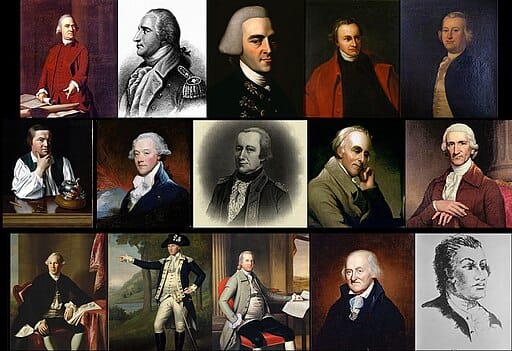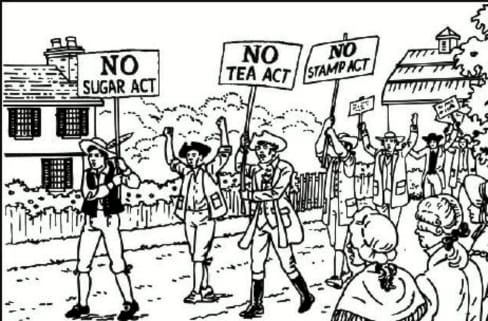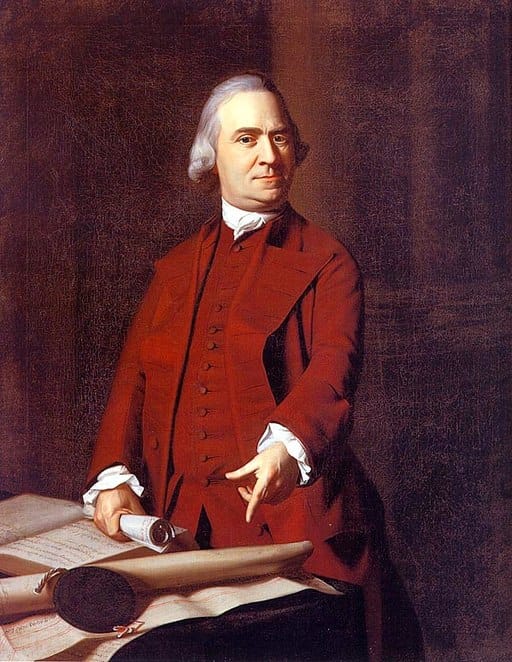The Sons of Liberty
“No taxation without representation!”
It wasn’t just a slogan. It was a slogan that echoed through the streets of colonial America, and behind it was a courageous group of rebels: The Sons of Liberty.
But who were these men? Why did they dump 300 chests of tea into Boston Harbor in the dark of night? And what was their true purpose?
Let’s explore the motivations behind this iconic rebellion–and the secret society that started the revolution.

Image via Wikimedia Commons. Public domain in the United States. [Original file]
Who were the Sons of Liberty
The Sons of Liberty were not your average colonial protestors. Formed in August 1765 in Boston, this underground network of American patriots had one mission: to resist British rule and protect colonial rights.
They emerged in direct response to the Stamp Act–a law that taxed everything from newspapers to playing cards. To the colonists, this wasn’t just another tax. It was an insult. They had no voice in British Parliament, yet they were being forced to pay for a war they didn’t start.
And so, they pushed back.
Samuel Adams, one of the group’s most passionate leaders, organized resistance that quickly spread across the colonies, from Massachusetts Bay to Virginia. Other notable members included John Hancock and Paul Revere, names now etched into American legend.
“If our trade be taxed, why not our lands, or produce, in short, everything we possess?” — Samuel Adams
What was the purpose of the Sons of Liberty
To understand their defiance, you need to understand their frustration.
After the French and Indian War, Britain had no money left. So they introduced the Stamp Act in 1765, requiring every official paper, license and even stamps to be purchased.
To the British, it was a fair ask.
To the colonists, it was tyranny.
Initially, the Sons of Liberty were protesting in the name of “Rights of Englishmen” – they believed that every British citizen (whom they still considered themselves) should have certain legal rights, including that they could not be taxed without an elected representative.
But gradually their ideas began to change.
Their thinking was not limited to just abolishing taxes.
Now they were dreaming of something else: independence, self-rule, and a democratic system.
What the Sons of Liberty did
Don’t misunderstand–the Sons of Liberty weren’t just peaceful protesters standing around holding signs.
They were activists, agitators, and in some cases, rebels.
Here are a few of their most daring acts:
- The Gaspee Affair (1772): A British customs ship was boarded and burned by patriots in Rhode Island—an early act of violent resistance.
- The Attack on John Malcolm: A Loyalist customs officer was tarred and feathered in public. It was brutal, symbolic, and sent a clear message to other loyalists.
- The Boston Tea Party (1773): Disguised as Mohawk warriors, members boarded British ships and dumped over 90,000 pounds of tea into Boston Harbor. Their goal? Protest the Tea Act, which gave unfair trade advantages to the British East India Company.
The Boston Tea Party: Why Tea?
Why tea? Because it was personal.
The Tea Act gave the British East India Company an unfair trade advantage. These were not accidental outbursts of anger.
These were planned civil disobedience acts–to incite people against British rule.
Boston Tea Party: Why tea? Because tea wasn’t just a drink, it was an emotional symbol. Tea was a huge part of British culture and colonial daily life.
When the Tea Act came in and the British began selling cheap tea directly to the colonies, not only was the business of the local merchants threatened, but their freedom was also threatened.
On December 16 1773, they silently boarded three ships–Dartmouth, Eleanor, and Beaver–and tossed 342 chests of British tea into the harbor. No violence. No theft. Just a bold, defiant statement.
They weren’t destroying tea.
They were destroying the illusion that Britain still had control.
Where were the Sons of Liberty Located
The movement that began in Boston soon spread throughout the colonies.
Local chapters of the Sons of Liberty formed in:
- New York
- New Jersey
- Maryland
- Rhode Island
- New Hampshire
- Virginia
The style was different everywhere, but the message was the same: Resist tyranny. Defend liberty.
The meetings were secret. They met at night in taverns, churches, or forests, risking their lives. Their coordination gave them power.
This wasn’t just a protest in Boston–it had become a colonial revolution.
Why Were the Sons of Liberty So Effective?
What made this ragtag group of rebels so influential?
- Grassroots Organization: They weren’t waiting for permission. They built local support networks from the ground up.
- Symbolism: Hanging effigies, dressing as Native Americans, or using newspapers to spread their message—they understood how to shape public opinion.
- Fearlessness: They didn’t just write letters—they took action. Risking imprisonment—or worse—they stood on the front lines of defiance.
They didn’t fear prison or death.
Most importantly, they captured the hearts and minds of the people. They turned ordinary people into revolutionaries through public protests, boycotts, and heroic actions.
What Was the Sons of Liberty’s Legacy?
The Sons of Liberty weren’t just protesting–they were preparing for war.
After the Boston Tea Party, Britain passed the Coercive Act (colonists called it the “Intolerable Acts”) and closed Boston Harbor.
But this repression didn’t end the rebellion–the colonies became even more united.
By 1775, the first shot had been fired. And these men had laid the foundation needed to awaken a nation. They never became an official army.
They never wore uniforms. But without them, the American Revolution might not have happened.
6 Facts about the Sons of Liberty
| Fact | Detail |
| Founded | August 1765, Boston |
| Founders | Samuel Adams, John Hancock |
| Ideology | Rights of Englishmen → Republicanism |
| Tactics | Protests, sabotage, civil disobedience |
| Key Events | Gaspee Affair, Boston Tea Party |
| Legacy | Fueled the American Revolution |
What Did the Sons of Liberty Hope to Achieve?
The Sons of Liberty weren’t just showing up for tea… they were ending obedience. Their goal was clear:
Their goal was clear: awaken the colonies, challenge authority, and demand representation and freedom.
Today, their name lives on as a symbol of resistance and the power of people to rise against oppression.
“It does not take a majority to prevail… but rather an irate, tireless minority, keen on setting brushfires of freedom in the minds of men.” — Samuel Adams


